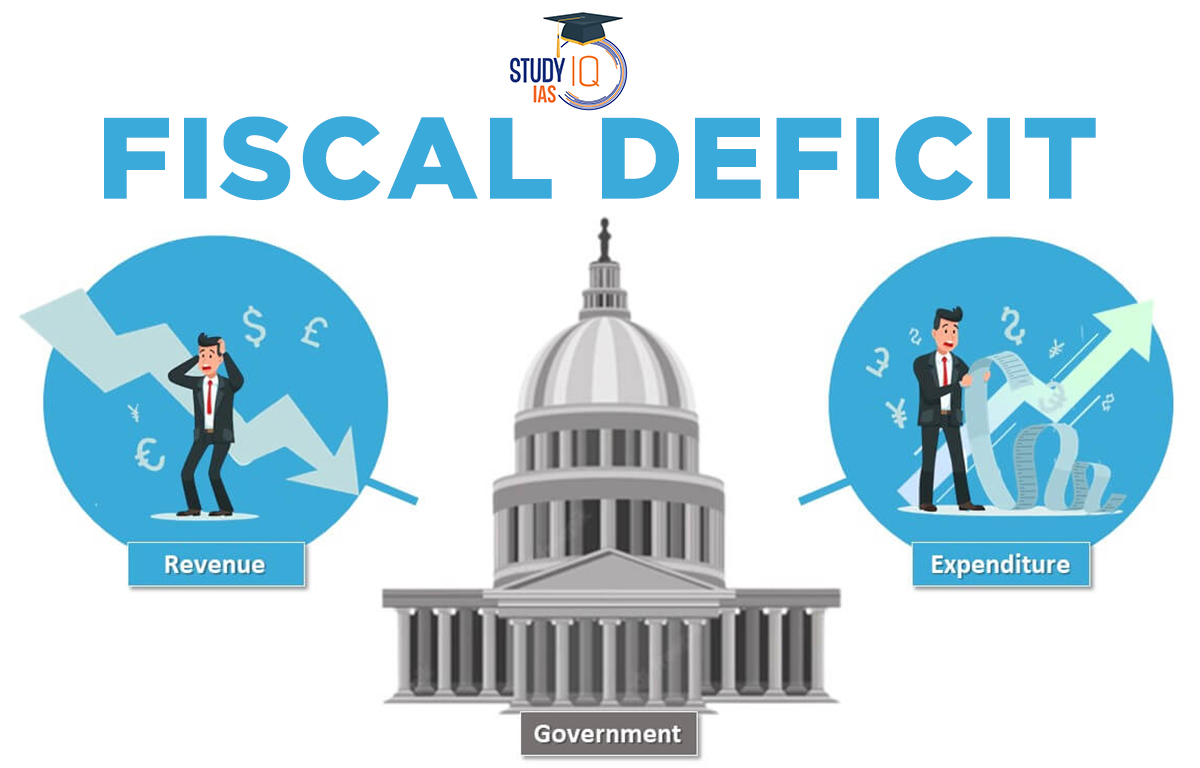Table of Contents
India’s fiscal deficit from April to February in the fiscal year 2023-24 stood at ₹15.01 trillion, accounting for 86.5% of the revised annual estimate, according to data released by the Controller General of Accounts. This figure highlights a significant aspect of India’s economic management, especially in a year marked by various challenges and fluctuations.
About Fiscal Deficit
- A fiscal deficit is the gap between the total expenditure and total income of the government.
- Fiscal Deficit = Government Revenue – Government Expenditure
- It indicates the extent by which government spending exceeds its income and the total borrowings needed by it to fill this gap.
- The government experiences a fiscal deficit when it spends more money than it takes in from taxes and other revenues.
- It is usually calculated and expressed as a percentage of a country’s Gross Domestic Product (GDP).
- Significance of Fiscal deficits: It can boost a sluggish economy by increasing the spending power of people for investment.
Budget FY2024 and Fiscal Deficit
- Fiscal Deficit Target: The government aimed to reduce the fiscal deficit to 5.8% of GDP in FY2024, down from 6.4% in the previous fiscal year.
- Budgeted Estimate: The initial budgeted estimate for the fiscal deficit in FY2024 was ₹17.35 trillion, as per the vote-on-account budget announced on February 1.
- Performance: As of February, the fiscal deficit stood at ₹15.01 trillion, accounting for 86.5% of the revised annual estimate. This indicates progress towards the fiscal consolidation target.
- Revenue and Expenditure: Total expenditure for FY2024 reached ₹37.47 trillion, with capital expenditure at ₹8.06 trillion and revenue expenditure at ₹29.42 trillion. Meanwhile, total receipts amounted to ₹22.46 trillion, primarily sourced from tax and non-tax revenues.
- Revenue Shortfall Mitigation: Despite challenges such as a shortfall in divestment targets, higher-than-expected tax and non-tax revenues, including dividends from the Reserve Bank of India and state-run banks, helped offset revenue shortfalls.
- Target: To reach a fiscal deficit below 4.5% by 2025-26.
We’re now on WhatsApp. Click to Join
Financing of Fiscal Deficit in 2023-24
India’s fiscal deficit, the shortfall between government expenditure and revenue, plays a pivotal role in the country’s economic landscape. In the fiscal year 2023-24, the Indian government faced the challenge of financing a sizable deficit amid various economic and fiscal dynamics. Understanding the strategies and mechanisms employed to finance this deficit provides valuable insights into the country’s financial management and its implications for the broader economy.
- Domestic Borrowing: Utilized issuance of government securities like treasury bills and bonds to raise funds from domestic markets.
- External Borrowing: Accessed international markets through sovereign bonds or loans from financial institutions to supplement funding needs.
- Revenue Enhancement: Implemented tax reforms, improved compliance, and pursued disinvestment to boost revenue generation.
- Monetization Caution: Exercised caution in deficit monetization to balance liquidity needs with inflationary risks.
- Fiscal Prudence: Emphasized fiscal discipline, expenditure rationalization, and subsidy reforms for long-term sustainability
Causes of Fiscal Deficit
- Increased Government Spending: When a government increases spending on programs or initiatives, it can lead to a higher deficit if revenue does not grow at the same rate.
- Lower Revenue: A decrease in revenue, such as a decline in tax revenues or a reduction in revenue from natural resources, can also contribute to a higher deficit.
- Economic Downturns: During an economic recession, government revenues may decrease while expenses increase, leading to a higher deficit.
- War or Natural Disasters: The costs of war or natural disasters can also contribute to a higher deficit as the government may need to increase spending to address these issues.
- Social Welfare: A country that has many social welfare programs running and is expensive to run may also cause a higher deficit.
- Interest on Debt: A government may also have to pay a significant amount of money in interest on its debt, which can also contribute to a higher deficit.
Disadvantages of Fiscal Deficit
- In the long term, a high level of debt is associated with slower growth.
- Huge deficits are seen in a largely negative light by international rating agencies and economy watchers.
- High borrowings could distort interest rates in the economy.
- Vicious Cycle of Debt: Persistent deficits increase government debt and take away a large portion of its revenues towards interest payouts.
- Inflationary Pressure: Printing fresh currency leads to the inflow of an additional quantity of money into the economy. Deficit financing can lead to inflation, that is, a rise in the prices of all commodities.
- Excessive dependence of a country on debt can hamper economic growth in the long term.
- A high deficit could result in less money to invest in development and job creation.
Way Forward
- Tame Inflation: Fiscal policy measures are crucial to tackle mounting inflation as interest rate management by the RBI through inflation targeting alone cannot effectively control inflation.
- Policy coordination between RBI and the Government is crucial for a sustained growth recovery process.
- Fiscal Prudence: Fiscal deficit estimates lower at 5.9% help the market gain greater confidence in the continuing fiscal prudence.
- Adherence to FRBM Act: The Fiscal Responsibility and Budget Management (FRBM) Act, 2003 requires the central government to progressively reduce its outstanding debt, revenue deficit and fiscal deficit, and give three-year rolling targets.
- The government’s aim is to reduce the fiscal deficit to below 4.5% of GDP by 2025-26.


 Dynamic Pricing: What It Is and Why It's...
Dynamic Pricing: What It Is and Why It's...
 Index of Industrial Production 2025, For...
Index of Industrial Production 2025, For...





















